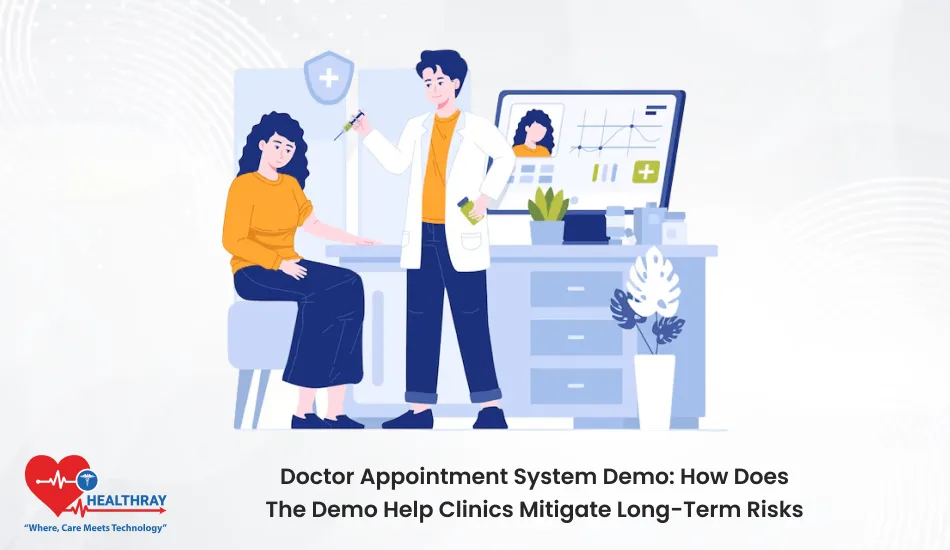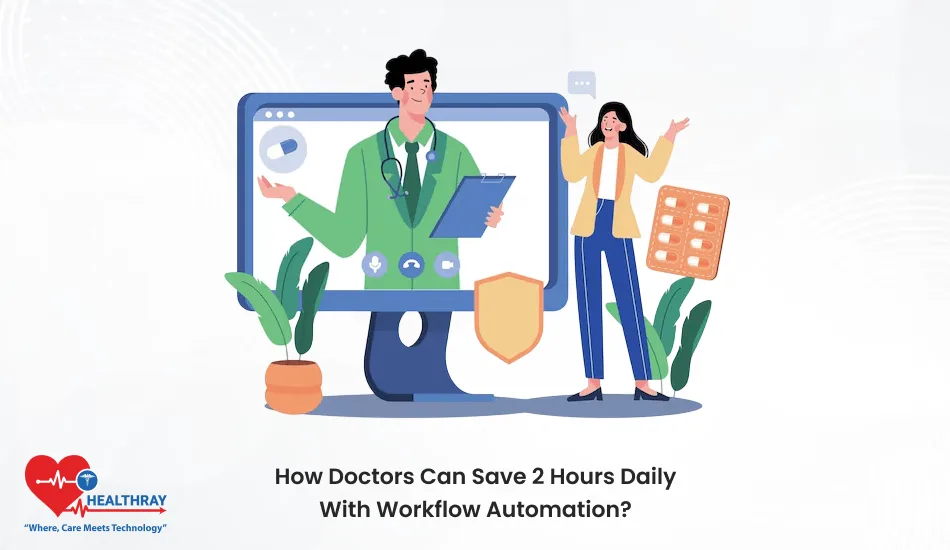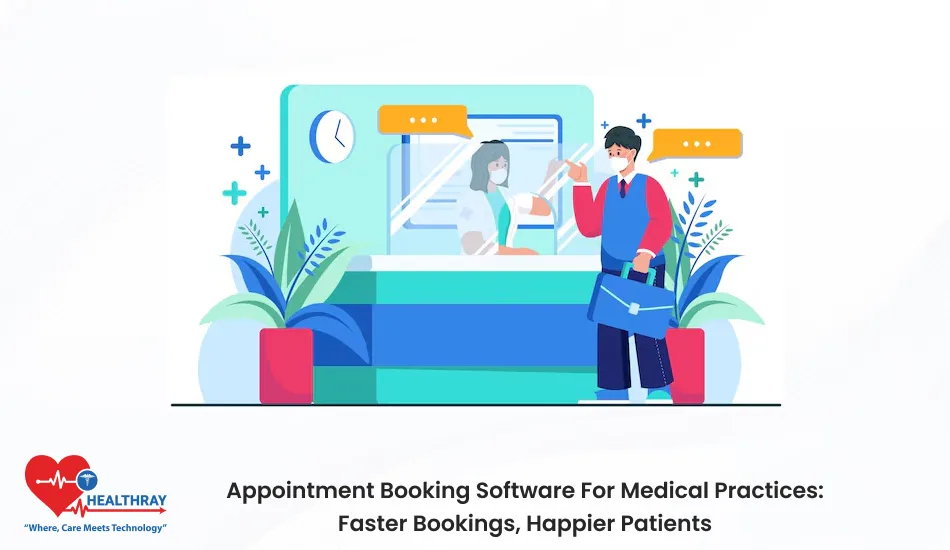Running a hospital has its own difficulties: staff shortages, haphazard schedules, administrative overload, and the list is long. For long, these adversities have led to problems in maintaining the well-being of employees and patients alike in the functioning of healthcare facilities.
AI-based human resource management system software has created revolutions in dealing with human resource functions in hospitals, ushering in automation, accuracy, and data-informed decision-making.
This article will discuss AI-based HRMS applications and their potentials in rebuilding operational efficiencies for hospitals. The hospital information management system focuses on minimizing the devotee’s administrative burden, closely following workforce management, and the indirect benefits these two interventions will provide to the patient care being imparted.
Understanding AI-Driven HRMS Software
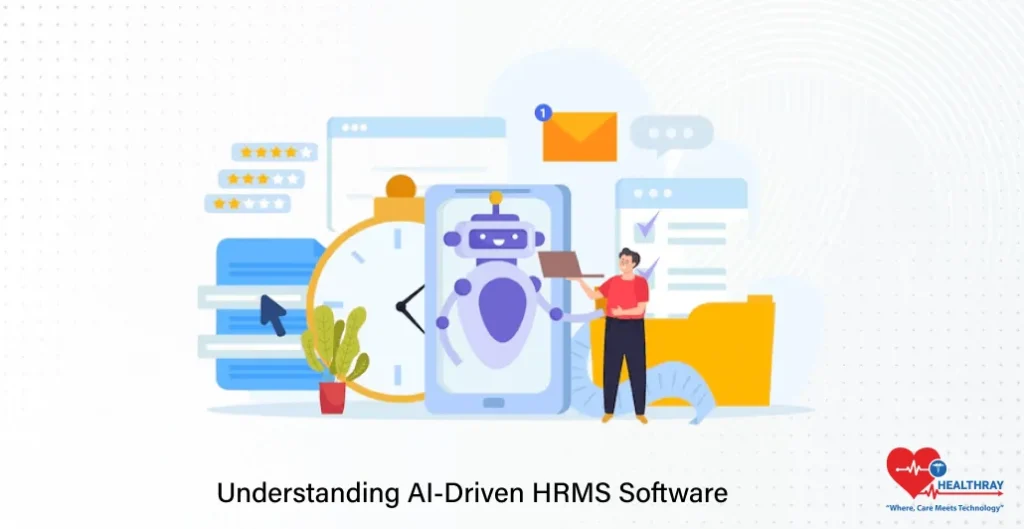
AI-driven HRMS software integrates human resource management systems and artificial intelligence and aims to develop more intelligent and efficient processes. These advanced systems do not function like regular HRMS tools but rely on algorithms to evaluate data, forecast patterns, and automate repetitive tasks.
In a hospital context, this actually means much more than storing employee data. AI-based HRMS can assess staffing gaps, suggest optimal schedules, and even help with the recruitment process by better evaluating candidates based on their resumes.
A unique feature of AI-based HRMS is predictive analytics. By examining historical data, it predicts trends that will affect the future, such as expected staff shortages at peak times. This allows administrators to make prior arrangements, thus facilitating smooth workflow and enhanced resource management.
Another important feature is the inclusion of machine learning, which will allow the system to enhance its accuracy with every interaction it makes over time, thereby gaining efficiency through use.
With these capabilities, AI HRMS tools are not just administrative aids but strategic partners in enhancing hospital performance through optimization.
Enhancing Operational Efficiency with AI-Driven HRMS
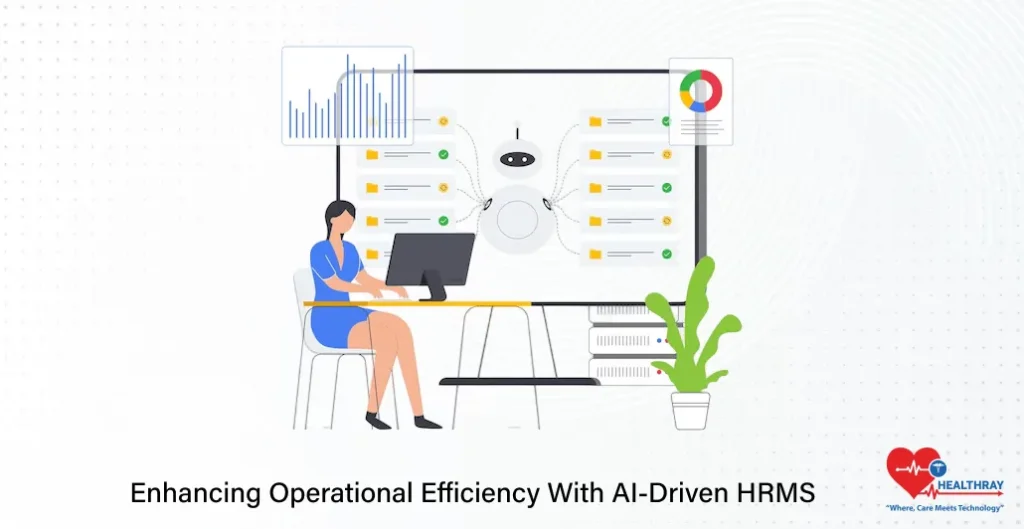
Managing a hospital, in itself, is a distinctly administrative task, requiring coordination of people and resources with surgical precision; any operational inefficiencies can compound into larger problems. AI-driven HRMS is here to be the game-changer in removing all such problems by means of smart automation-and-data insights.
Automating Repetitive Tasks
Payroll processing, attendance checking, leave management-all such administrative tasks take precious man-hours. An HRMS with AI automation of this process saves time that would otherwise be spent on repetitive tasks while minimizing possible errors made by humans. For instance, biometric-based computerized attendance systems can be applied to track staff working hours, thereby avoiding discrepancies and saving hours of work from the HR teams.
Optimum Staff Scheduling
Staffing scheduling can be torturing in a hospital with demand spiraling up and down according to emergencies, season ailments, and patient admissions. Again, it is the same AI that came up with solutions with an analysis of past data and current demands-optimizing schedule suggestions that minimize overtime while ensuring all functions are covered. This has the feedback impact of avoiding fatigue among staff and increasing satisfaction.
Data-Driven Resource Allocation
AI-driven HRMS does not limit the scope of its activities purely to personnel management; it also helps provide input for resource allocation. For instance, the software could provide alerts when certain departments appear to be overstaffed or underworked. On these bases, administrators could reassign personnel in areas of high demand while ensuring effective use of resources.
Faster Decision-Making
Accessing accurate data is paramount during operational decision-making. An AI-powered HRMS comes equipped with real-time dashboards providing insight into current staffing levels, impending leave requests, and performance trends; thus, health information management systems administrators and HR teams are positioned to make well-informed decisions fast.
The operational efficacies shall flow into smoothened functioning, reduced costs, and a satisfied workforce-oriented outlook toward patient care.
Improving Patient Care with AI-Driven HRMS

At the heart of any hospital’s mission lies patient care. HRMS software mostly deals with managing the people and resources of the hospital, and yet the influence of HRMS on patient outcomes cannot be underestimated. AI-driven HRMS tools provide a platform for optimal patient care via maximally organized workforces and minimized operational interruptions.
Finding the Right Balance
Staffing shortages or management catastrophes have been observed to lead to overworked employees, delay in delivery of services and inconsistency in the quality of care provided.
AI-driven HRMS tools will look at patterns of patient admission with ambient data such as patient load during peak hours and historical data in order to determine staffing needs. This ensures that just the right amount of staff is available at all times, thus alleviating unnecessary stress on employees and cutting down waiting time for patients.
Minimizing Errors in Resource Allocation
In order to put it correctly, such an environment always comes under pressure, and thus errors in resource allocation come at a cost. Such errors are identified by AI-powered systems, instantly generating alerts about the inefficacy being flagged and adjustments recommended. For instance, if a certain department is under-resourced during a certain critical time, the system will notify the administrator such that the situation can be rectified before it impacts the patient care.
Reducing Burnout Among Healthcare Staff
Burnout of health workers almost directly bears on patient care: if an AI tool can support equitability in workload distribution, recognize overworked individuals, and suggest altering their work schedules to offload some staffing duties, certainly happier and well-rested staff would deliver a great deal more patient care that is attentive and empathetic.
Improving Communication Across Teams
In a hospital environment, smooth communication is of the essence. Especially in the transfer of patients between departments, AI-assisted HRMS systems can integrate with other hospital management tools to ensure that the staff has instant access to updated schedules and information on patients. This synchronization prevents potential delays and enhances the overall experience for patients. With the genogram maker, streamlines coordination among all departments.
Indirectly by eliminating inefficiencies within workforce management, this will ameliorate the care received by patients. Hospitals seem to favor higher morale and efficiency, and the patients enjoy better results and reduced waiting times.
Real-World Applications and Case Studies

AI-assisted HRMS software does not remain a speculatory futuristic suggestion; it is already in full play affecting hospitals across the globe. Let’s consider some real-life examples that speak of the efficiency and outcome improvement brought in by these systems.
Streamlining Staffing in a Multi-Specialty Hospital
The emergency department of a large multi-specialty hospital often faced complexities owing to frequent staff shortages. Traditional scheduling, implemented even against fluctuating patient volumes, always delayed in providing adequate staff, leaving those present few overworked. With AI-driven HRMS, the hospital analyzed admission patterns and staff availability, setting up predictive schedules, making sure that the right number of staff was always on duty. Within three months, this reduced overall patient wait time by 30% and saw a significant improvement in employee satisfaction scores.
Improving Recruitment in a Regional Healthcare Network
A regional health provider was having long hiring cycles for critical positions, like nursing and technician roles. The manual screening of candidates, mostly through paperwork, turned out to be a lengthy business that sometimes ended with the selection of the wrong person to fill the position. Following the introduction of an AI-based HRMS, the additional automation for papers became possible; screen CVs applying pre-analyzed criteria such as qualification, experience, and locational distance. Hiring time was reduced by 40%, and the quality of hires improved, thus reducing turnover rate.
Reducing Administrative Burden in A Teaching Hospital
A teaching hospital was challenged at the time with administrative task processing such as payroll, attendance, and performance reviews. The manual processes were prone to errors and required hospitals to spend chunk time that should have been for HR productivity. AI-driven HCM software automated workloads, gave real-time insights into staff performance, and tracked attendance trends. Lifting such a load allowed HR to focus on strategic initiatives instead of day-to-day operational issues, with a resultant boost in overall productivity.
General Trends in Adoption
The hospitals that adopt AI human resource management tools do see the same result: lower operational costs, better workforce utilization, and patient care outcomes. Maintaining quality standards under the complexities of healthcare demand has made AI HRMS solutions a sine qua-non.
Such real-life applications showcase the common benefits AI HRMS systems bring about. These real-life applications are not just tangible but are also needs for more operational hospitals willing to be market competitive and efficient.
Challenges and Considerations for Implementing AI-Driven HRMS Hospital Software
The AI-powered HRMS software could catapult hospitals into a whole new operational paradigm, but there are many thorny challenges to address. Understanding those potential roadblocks is important for successful implementation.
Resistance to Change
Any new technology will face suspicion from the staff. Old-timers comfortable in their previous ways might doubt whether they could turn adaptive to any new system, not other employees fear for their jobs out of concern for automation. It takes efficient communication and training to allay such fears and show the staff the benefits afforded through AI-driven HRMS tools.
High Initial Investment
AI systems in health services would normally entail high initial investments in software, hardware, and training. Smaller hospitals or the ones already stricken on budget may be deterred from making the commitment. Highlighting the long-term ROI based on reduced staffing administration and the efficiency levels achieved, however, will make further arguments for adoption.
Data Privacy and Security
Hospitals hold sensitive information databases on employees and patients. The implementation of AI HRMS to store and process that information will pose questions of privacy and security. The essentials underlying high privacy risk topics include compliance with health regulations such as HIPAA and the adoption of high-level encryption.
Integration with Existing Systems
Hospitals operate different software for functions such as patient records, billing, and inventory management. The integration of the HRMS AI with already existing systems can pose a technical challenge. Whenever these sorts of technical requirements come in, the better approach would be to either select a software solution with strong integration or to partner with an expert IT team.
Customization Needs
Each hospital differs in its requirements depending on the consideration of size, specialty, and workforce structure. Ready-made HRMS solutions may not get somewhat regarded as acceptable. Customization according to particular workflows and aims might be time and resource consuming; however, it guarantees maximum utility in the longer term.
Maintaining Regular Upgrades
Systems powered by AI must go through updates regularly to conform to developments and keep abreast with accuracy. Hence, hospitals must ensure that they allocate resources for continued maintenance and that the IT teams are well prepared to carry out upgrades as they come and respond to troubleshooting when it does arise.
Training and Adoption of the Staff
To be able to reap the benefits of AI-driven HRMS, the staff should be knowledgeable and capable of using this system properly. These could be achieved through proper training courses and support during the transition period.
With these challenges in place, it is ensured that hospitals will not only ascertain maximum benefits from the implementation of AI-driven HRMS.
Future Aspect of AI-Driven HRMS for Hospital
The role that AI plays within healthcare is ever-growing on the pace, and HRMS software is no exception. Those hospitals embracing these tools-even today-are preparing themselves better for efficiency, adaptability, and eventual success of their operations down the road. Here, then, is the future of AI-driven HRMS in hospital management.
Greater Integration with Healthcare Systems
With the advent of AI, future HRMS tools will likely implement even greater integration with HMIS software. This facilitates even better data sharing among departments-HR to patient care units-and result in operations that are more coordinated and efficient.
Advanced Predictive Analysis
With the advent of even more sophisticated AI algorithms, forecasting with the help of HRMS tools will take on deeper significance. Hospitals will thereby be able to predict with extreme accuracy their long-term staffing needs, plan for seasonal demand fluctuations, and expect inertia in the face of emerging challenges.
Custom Employee Experience
The next-level breed of HRMS will be focused on customization, with tailored solutions for employee engagement, sustenance, and career advancement. Depending on the data collected for an individual employee, the AI may recommend various training programs, career pathways, or even initiatives fostering wellness and good health, thus cultivating an even more satisfied and productive workforce.
Again, AI systems will enhance the decision-making capacity of hospital managers by assisting them in making various choices. AI will offer suggestions for saving costs, highlighting compliance risks, and speed the decision-making process for hospital leaders through enhanced information dissemination to actual decisions.
Enhanced Accessibility for Smaller Healthcare Institutions
Cloud-based HRMS solutions will become even more popular, thus making it easier for hospitals to scale. This will make advanced AI-driven HRMS tools handy for smaller healthcare facilities with a lack of IT infrastructure.
Empowerment of Employee Wellness
With burnout becoming common knowledge in the healthcare environment, future HRMS tools can only get better on their road towards a more well-rounded employee. Future HRMS can keep track of workloads, track signs of impending stress, and promote action to ensure staff stay in good health and maintain a healthy work-life balance.
AI Ethics and Transparency
With the increasing role of AI-related technologies in HRMS, there is growing demand for ethical AI. The hospitals would insist on algorithm transparency for decision-making, especially with recruitment and performance evaluation.
The future of AI-driven HRMS appears very auspicious, offering smart solutions for the most efficient hospital management. By keeping abreast of the above trends, the hospitals can ensure that the best possible care is provided alongside the workforce.
Conclusion
AI-driven HRMS software is transforming hospitals. By automating administrative tasks, optimizing staffing, and providing insights, these systems address antiquated inefficiencies that pose barriers to operation. They ensure greater efficiency of the workflow, greater satisfaction of employees, and, in the end, greater care of the patients.
The challenges of integration and initial investments have to be managed adeptly, as these tools find their way into hospitals. The dividends accruable from them are far greater than the hurdles, bringing in a more efficient and data-driven scheme of hospital management.


